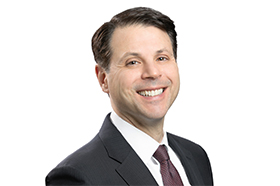Prioritize tech, outsourcing and transparency
Asset managers are walking a tightrope in a storm that has shown some clearing of late.
They’re trying to keep their footing amid economic headwinds that demand greater cost efficiencies. They’re balancing the ever-changing demands of clients and regulators. They’re acutely aware of the cybersecurity risks and other threats awaiting a single misstep.
And to make it to the other side, they’ll need to improve their operational efficiency while becoming more risk-resilient. That was the message of a recent Grant Thornton panel on driving growth in the asset management industry, which was part of the firm’s Executive Forum Series and provided practical insights and predictions on the topic.

“Organizations that prioritize operational efficiency are better positioned to adapt, innovate and thrive.”
The insights focused on:
- How automation can simultaneously improve customer satisfaction and efficiency
- The risks and opportunities of the “traditional” and “strategic” models of outsourcing
- Managing cybersecurity risks and responsibilities, including new disclosure requirements
“In today’s business landscape, where competition is fiercer than it's ever been and customer demands are constantly evolving, organizations that prioritize operational efficiency are better positioned to adapt, innovate and thrive,” Grant Thornton National Managing Principal for Growth Advisory Scott McGurl said during the webcast.
“It enables them to stay competitive, deliver value to investors and achieve long-term success. In other words, this is mission-critical. This separates the winners from the losers in the future,” he added.
Automation and efficiency for asset managers
Efficiency improvements can range from relatively simple technological upgrades to wholesale organizational restructuring.
One good example of a highly beneficial but somewhat simple improvement comes from National Managing Partner for Asset Management Michael Patanella, who moderated the panel. He described a client that has a robust website and a dedicated app but was receiving frequent requests from investors for more specific and detailed reports.
“So, the company looked at different ways that they could streamline that process to eliminate the resource drag to reply to inquiries,” he said.
The investment in a more robust report-generating tool had a twofold payoff: Investors got the transparency they wanted and the process of providing those reports became more automated and efficient.
Much larger-scale reorganizations, meanwhile, can prepare a company for unpredictable changes in the market. McGurl worked with a Fortune 50 organization on a project that began a decade ago. The organization was largely focused on financial activities such as asset management and trading, and after more than a century of growth, it was “highly fragmented, somewhat decentralized and entrepreneurial.”
With declining operating margins, McGurl and the CFO worked to harmonize systems across the enterprise, examining activities from source-to-pay, record-to-report, order-to-cash and hire-to-retire.
The goal was “looking at what those interplays are across the entire ecosystem and how to minimize the handoffs.” And achieving that meant not just changing systems but reforming how and where people worked.
“The result was an absolute redefinition of the enterprise operating model shift to a multisite, global, multifunction shared services organization that had streamlined processes,” McGurl said. That harmonization proved an enormous benefit as the pandemic arrived, with the client finding that its processes could be both virtualized and automated.
It’s estimated the project has delivered $3 billion in savings, McGurl added. And it worked because it was not just about buying the best technology but instead about achieving specific objectives.
“What do you want to do differently with the technology?” he asked. “Don't design the technology or redesign the technology to support your existing operations exactly how you're structured today. Look towards the efficiencies you can drive in the future.”

“It’s no longer just automating processes for efficiencies, but how do we leverage that to add value from a strategy perspective for the future.”
Increasingly, these efforts will involve artificial intelligence and automation. Leaders must think through the biases that may be introduced by the technology, as well as privacy and security considerations. And, ultimately, even the most data-centric upgrades must be linked back to core business goals.
“It’s no longer just automating processes for efficiencies, but how do we leverage that to add value from a strategy perspective for the future?” said Grant Thornton Leader, Advisory Services, Asset Management, Charmone Adams. “How do I weigh in on my portfolio? How do I make sound decisions? How do I use technology to give the best value not just to our portfolio but to our investors?”
‘Traditional’ vs. ‘strategic’ outsourcing
Market pressures may push more asset managers to consider outsourcing — and they’ll have to choose between two major models of outsourcing.
“Traditional” outsourcing is, of course, the stereotypical version of the model: Work is shifted to a third-party partner, allowing the company to cut internal staff or minimize staff growth.
“Oftentimes, it is a pure cost reduction play,” McGurl said. “How do I drive near-time financial results and benefits?”
But a purely transactional relationship is often unsuccessful. Instead of improving its internal operations, the client is allowing the vendor to “capitalize on your inefficiencies,” McGurl said. And those clients will often seek to insource the work again later.
In contrast, the “strategic” approach aims to supplement, not replace, the work of the client organization. Ideally, a strategic outsourcing partner will bring complementary competencies and capabilities.
“I see organizations now looking at it with a much more strategic lens,” McGurl said. “How do we partner with other organizations, third parties, to create long-term value?”
The strategic model can include a wider range of work — not just support and service roles but also knowledge-based work such as planning, analysis and decision support.
No matter the model, it’s crucial for the client to safeguard against the loss of value and knowledge. That means retaining and developing expertise in all business functions, even if some work is being outsourced. Success also requires a strong contract, as well as privacy and security protections.
“Make sure that you do the diligence, have the right service levels, have the right clawbacks in place, and you've got a phenomenal governance framework around it,” McGurl said.
Cybersecurity risks and responsibilities
Cybersecurity has been an issue for years, but there’s been a change in how some asset managers approach the risk.
“In the past, a lot of entities sometimes would maybe pay off a ransom to get their data back, or not report it, because they felt that it would be a negative,” Patanella said.
Now, there’s greater regulatory and investor pressure to proactively address and disclose cybersecurity risks, including through the SEC’s new Form 8-K rules for reporting material cybersecurity incidents that took effect Dec. 18, 2023.
Regulators are “looking for companies to convey to the public and to their investors how cybersecurity risks are managed within the enterprise and whether they're part of the registrants’ overall risk management program, whether third parties, assessors or auditors are used as part of that process,” said Grant Thornton, Managing Director for Cybersecurity and Privacy Advisory Services Maxim Kovalsky.
The SEC will require companies to disclose whether cybersecurity threats, including previous incidents, have materially affected or are reasonably likely to materially affect the company’s business strategies, financial conditions or results of operations.
Finally, companies face new reporting requirements for data breaches and other incidents.

“When a company falls victim to a cyber incident, the expectation of the SEC is that the registrant reports it within four business days on the Form 8-K after determining that cyber incident was material.”
“When a company falls victim to a cyber incident, the expectation of the SEC is that the registrant reports it within four business days on the Form 8-K after determining that cyber incident was material,” Kovalsky said. That could include a single incident or a series of smaller incidents that collectively could be deemed material by a reasonable investor.
Beyond simply obeying the regulations, “it comes back to the clients that asset managers serve,” Kovalsky added.
Ultimately, asset managers serve their clients better when they prioritize protecting sensitive information, improve efficiency through outsourcing and deliver better capabilities through improved technology. And the asset managers who serve their investors will walk the tightrope successfully in the stormy conditions.
Contacts:







Leader, Advisory Services, Asset Management
Partner, Risk Advisory Services
Grant Thornton Advisors LLC
Charmone is a Principal in the Risk Advisory Services practice. Charmone has a diverse background in public and private accounting which spans across multiple industries.
Manhattan, New York
Industries
- Asset Management
- Private Equity
- Banking
Service Experience
- Advisory Services
- Risk Advisory
Trending topics

No Results Found. Please search again using different keywords and/or filters.
Share with your network
Share